- Extra Points of the Head and Neck (EX-HN* note: coded by WHO, 1989, Geneva)
- EX-HN 1 Sishencong
- EX-HN 2 Dangyang (当阳)
- EX-HN 3 Yintang (印堂)
- EX-HN 4 Yuyao (鱼腰)
- EX-HN 5 Taiyang (太阳)
- EX-HN 6 Erjian (耳尖)
- EX-HN 7 Qiuhou (球后)
- EX-HN 8 Shangyingxiang (上迎香) /Bitong (鼻通)
- EX-HN 9 Neiyingxiang (内迎香)
- EX-HN 10 Juquan (聚泉)
- EX-HN 11 Haiquan (海泉)
- EX-HN 12 and 13 Jinjin (金津) and Yuye (玉液)
- EX-HN 14 Yiming (翳明)
- EX-HN 15 Jingbailao (颈百劳)
- Qianzheng (牵正)
- Jiachengjiang (夹承香)
- Anmian (安眠)
- Extra Points of the Chest and Abdomen (EX-CA)
- Extra Points of the Back (EX-B)
- EX-B 1 Dingchuan (定喘)
- EX-B 2 Jiaji (夹脊) or Huatuojiaji(华佗夹脊)
- EX-B 3 Weiwanxiashu (胃脘下俞) or Yishu (胰俞)
- EX-B 4 Pigen (痞根)
- EX-B 5 Xiajishu(下极俞)
- EX-B 6 Yaoyi (腰宜)
- EX-B 7 Yaoyan (腰眼)
- EX-B 8 Shiqizhui (十七椎)
- EX-B 9 Yaoqi (腰奇)
- Extra Points of the Upper Extremities (EX-UE)
- EX-UE 1 Zhoujian (肘尖)
- EX-UE 2 Erbai (二白)
- EX-UE 3 Zhongquan (中泉)
- EX-UE 4 Zhongkui (中魁)
- EX-UE 5 Dagukong (大骨空)
- EX-UE 6 Xiaogukong(小骨空)
- EX-UE 7 Yaotongdian (腰痛点)
- EX-UE 8 Wailaogong (外劳宫)
- EX-UE 9 Baxie (八邪)
- EX-UE 10 Sifeng (四缝)
- EX-UE 11 Shixuan (十宣)
- Jianqian (肩前)/Jianneiling (肩内陵)
- Extra Points of the Lower Extremities (EX-LE)
At the Geneva meeting in 1989, the WHO (World Health Organization) Scientific Group reviewed and adopted the 48 Extra Points.
In its review of the 48 Extra Points, the Scientific Group used the following criteria:
- The point should be in common use.
- It should be considered clinically effective.
- It should have a clear anatomical location.
- It should be at least 0.5 cun from a classical acupuncture point.
- If it has the same name as an existing point, a prefix should be added to it.
The proposed alphanumeric code consists of a general prefix, “EX” (denoting “extra point”), followed by an alphabetic code indicating the region (HN for head and neck, CA for chest and abdomen, B for back, UE for upper extremity, and LE for lower extremity). Points are numbered from the higher to the lower level for the head, neck, and trunk regions; from the proximal to the distal for the upper and lower extremities; and, if at the same level, from the medial to the lateral. Extra points without codes have not been standardized by the WHO.
Extra Points of the Head and Neck (EX-HN* note: coded by WHO, 1989, Geneva)
EX-HN 1 Sishencong
Name: Four Spirits/Shen Clarity. There are four points under this one name, functioning to affect the spirit.
Location: A group of four points, at the vertex, 1 cun respectively posterior, anterior, and lateral to GV 20 Baihui (Sishencong).
Actions: Clears the head and calms the shen, or spirit.
Indications: Headache, vertigo, insomnia, poor memory, epilepsy, mania, hemiplegia.
Method: Puncture subcutaneously 0.3–0.5 cun. Moxibustion is applicable.
EX-HN 2 Dangyang (当阳)
Name: Just on the Yang. The name refers to its location on the head, top and frontal, all belonging to Yang.
Location: Directly above the pupil or the center of the eyebrow, 1 cun within the hairline (Extra points on front facial area).
Actions: Clears wind-heat and brightens the eyes.
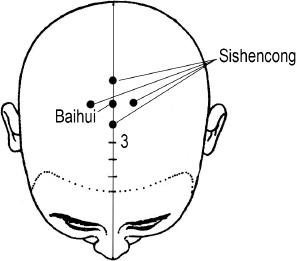
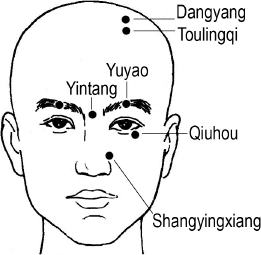
Indications: Headache, dizziness, eye diseases.
Method: Puncture subcutaneously 0.3–0.5 cun. Moxibustion is applicable.
EX-HN 3 Yintang (印堂)
Name: Seal Hall. It is the Chinese name for the glabella, on which the point is located.
Location: Midway between the medial ends of the two eyebrows, in the center of the glabella (Extra points on front facial area).
Actions: Calms the spirit, dispels wind-heat, and clears the nose.
Indications: Headache, head heaviness, nasal obstruction, epistaxis, rhinorrhea, infantile convulsions, facial pain, insomnia, Dian Kuang or Manic–Depressive Syndrome (bipolar disorder or schizophrenia).
Method: Puncture subcutaneously (usually downward) 0.5–1 cun. Moxibustion is applicable.
EX-HN 4 Yuyao (鱼腰)
Name: Fish Lumbus. The eyebrow resembles a fish, and the point is located right on its lumbus.
Location: At the central point of the eyebrow (Extra points on front facial area).
Actions: Brightens the eyes and dispels wind-heat.
Indications: Pain in the supraorbital region, twitching of the eyelids, ptosis, cloudiness of the cornea, redness, swelling and pain of the eyes.
Method: Puncture subcutaneously 0.5–1 cun. Moxibustion is not advisable.
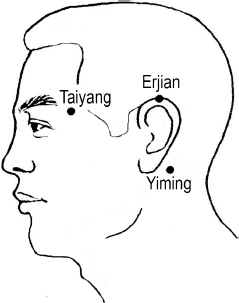
EX-HN 5 Taiyang (太阳)
Name: Sun. The area where the point is located is called “Taiyang” in Chinese.
Location: In the depression about 1 cun posterior to the midpoint between the lateral end of the eyebrow and the outer canthus (EX-HN 5 Taiyang and EX-HN 6 Erjian).
Actions: Brightens the eyes, dispels wind, and clears heat.
Indications: Headache, common cold, eye diseases, deviation of the eyes and mouth.
Method: Puncture perpendicularly 0.3–0.5 cun or obliquely (usually toward the temple or occipital region) 0.5–0.8 cun, or prick to cause bleeding. Moxibustion is usually not applied.
EX-HN 6 Erjian (耳尖)
Name: Ear Apex. The point is located on the tip of the auricle.
Location: Fold the auricle forward, and the point is at the apex of the auricle (EX-HN 5 Taiyang and EX-HN 6 Erjian).
Actions: Clears heat, dispels wind, and benefits the eyes and throat.
Indications: Redness, swelling and pain of the eyes, cloudiness of the cornea, febrile diseases, headache, sore throat.
Method: Puncture subcutaneously (usually downward) 0.1–0.2 cun or prick to cause bleeding. Moxibustion is applicable.
EX-HN 7 Qiuhou (球后)
Name: Behind the Eyeball. The name refers to its location.
Location: At the junction of the lateral one quarter and the medial three quarters of the infraorbital margin (Extra points on front facial area).
Actions: Brightens the eyes.
Indications: Eye diseases.
Method: Push the eyeball upward gently, then puncture perpendicularly 0.5–1.2 cun along the orbital margin slowly without lifting, thrusting, twisting, or rotating. No moxibustion is allowed.
EX-HN 8 Shangyingxiang (上迎香) /Bitong (鼻通)
Name: Upper Welcome Fragrance/Nose Passage. The point is superior to LI 20 Yingxiang. “Bitong” means “nasal passages” or to “drain the nose”.
Location: At the upper end of the nasolabial groove (Extra points on front facial area).
Actions: Clears heat, dispels wind, opens the nose, and brightens the eyes.
Indications: Nose diseases, red and swollen eyes, frontal headache.
Method: Puncture obliquely (usually upward) 0.3–0.5 cun. Moxibustion is not advisable.
EX-HN 9 Neiyingxiang (内迎香)
Name: Inner Welcome Fragrance. The point is opposite LI 20 Yingxiang, and is located inside the nasal cavity.
Location: Inside the nasal cavity, at the superior and lateral inner wall of the mucous membrane of the nostril (EX-HN 9 Neiyingxiang).
Actions: Opens the nose, brightens the eyes, and clears heat.
Indications: Nose diseases, redness and swelling of the eyes.
Method: Prick to induce bleeding. Moxibustion is not applicable.
EX-HN 10 Juquan (聚泉)
Name: Gathering Spring. At this point, the saliva is often rich like a gathering spring.
Location: In the center of the dorsum of the tongue (EX-HN 10 Juquan).
Actions: Benefits the tongue and arrests cough and asthma.
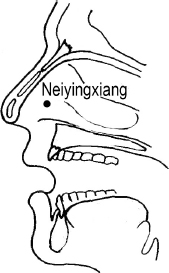
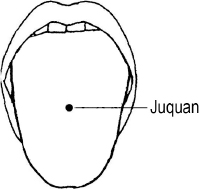
Indications: Tongue diseases, Xiao Ke or Consuming-Thirst Syndrome (roughly comparable to diabetes), cough and asthma.
Method: Puncture perpendicularly 0.1–0.2 cun. Moxibustion is not applicable.
EX-HN 11 Haiquan (海泉)
Name: Sea’s Spring. “Spring” here suggests saliva as for the above-mentioned point, EX-HN 10 Juquan.
Location: In the center of the frenulum (Extra points on the back of the tongue).
Action: Clears heat.
Indications: Stiff tongue, hiccups, Xiao Ke (consuming thirst or diabetes), sore throat.
Method: Prick to cause bleeding. Moxibustion is not applicable.
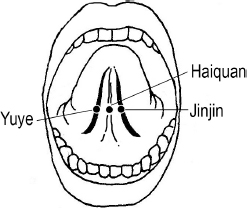
EX-HN 12 and 13 Jinjin (金津) and Yuye (玉液)
Name: Golden Liquid and Jade Humor. “Jin” and “Ye” describe the saliva in the mouth to be as important as gold and jade.
Location: On the veins on both sides of the frenulum of the tongue; Jinjin is on the left and Yuye on the right (Extra points on the back of the tongue).
Actions: Clears heat and benefits the tongue and throat.
Indications: Swelling of the tongue, vomiting, aphasia with stiffness of the tongue.
Method: Puncture Subcutaneously and medially 0.3–0.5 cun.
EX-HN 14 Yiming (翳明)
Name: Shielding Brightness. The name refers to its Function on the eyes.
Location: One cun posterior to TE 17 Yifeng .
Actions: Brightens the eyes, calms the shen or spirit, and dispels wind.
Indications: Eye diseases, tinnitus, insomnia, headache, dizziness.
Method: Perpendicularly 0.5–0.8 cun. Moxibustion is applicable.
EX-HN 15 Jingbailao (颈百劳)
Name: Neck Hundred Overstrain. The point treats all kinds of neck overstrain.
Location: Two cun above GV 14 Dazhui, 1 cun lateral to the Du Meridian (EX-HN 15 Jingbailao).
Actions: Transforms phlegm, nourishes the lung, and stops cough and asthma.
Indications: Luo Li or scrofula, cough, asthma, whooping cough, neck rigidity, tidal fever.
Method: Puncture perpendicularly 0.3–0.5 cun. Moxibustion is applicable.
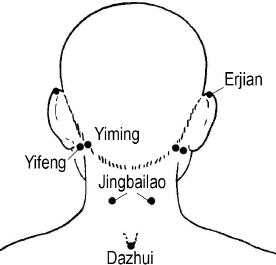
Qianzheng (牵正)
Name: Pull Aright. The point functions to correct the deviation of the mouth.
Location: 0.5–1 cun anterior to the auricular lobe.
Actions: Dispels wind, clears heat, and frees the collaterals.
Indications: Deviation of the eyes and mouth, ulceration of the tongue and mouth.
Method: Puncture obliquely 0.5–1 cun. Moxibustion is applicable.
Jiachengjiang (夹承香)
Name: Beside Liquid Receiver (RN 24). The name refers to the location of the point on both sides of CV 24 Chengjiang.
Location: One cun lateral to CV 24 Chengjiang, on both sides.
Actions: Dispels wind-heat and frees the collaterals.
Indications: Deviation of the mouth, toothache, swelling of the gums.
Method: Puncture obliquely or horizontally 0.5–1 cun. Moxibustion is applicable.
Anmian (安眠)
Name: Pacifying Sleep. It promotes a peaceful sleep.
Location: Midway between TE 17 Yifeng and GB 20 Fengchi.
Actions: Calms the spirit and improves the quality of sleep.
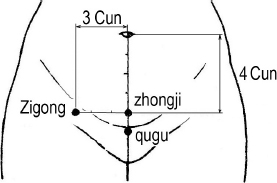
Indications: Insomnia, vertigo, headache, palpitations, mania.
Method: Puncture perpendicularly 0.5–0.8 cun. Moxibustion is applicable.
Extra Points of the Chest and Abdomen (EX-CA)
EX-CA 1 Zigong (子宫)
Name: Uterus. It treats disorders of the uterus.
Location: Three cun lateral to CV 3 Zhongji, i.e. 4 cun below the umbilicus (EX-CA 1 Zigong).
Actions: Regulates menstruation and raises Yang-Qi.
Indications: Prolapse of the uterus, irregular menstruation.
Method: Puncture perpendicularly 0.8–1.2 cun. Moxibustion is applicable.
Extra Points of the Back (EX-B)
EX-B 1 Dingchuan (定喘)
Name: Soothing Asthma. The name refers to its function.
Location: 0.5 cun lateral to GV 14 Dazhui (Extra points on the back).
Actions: Arrests cough and asthma.
Indications: Asthma, cough, neck rigidity, pain in the shoulder and back, rubella.
Method: Puncture perpendicularly 0.5–0.8 cun. Moxibustion is applicable.
EX-B 2 Jiaji (夹脊) or Huatuojiaji(华佗夹脊)
Name: Bilateral Spinal Points or Hua Tuo’s Paravertebral Points. Huo Tuo was a well-known doctor who practiced acupuncture in China about 2000 years ago. He found these points and they carry his name.
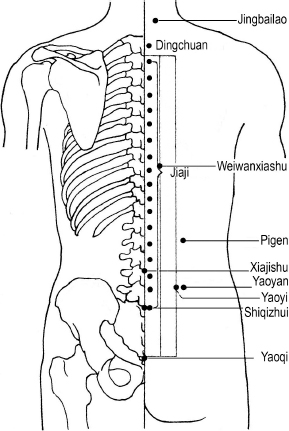
Location: A group of 34 points on both sides of the spinal column, 0.5 cun lateral to the lower border of each spinous process from the first thoracic vertebra to the fifth lumbar vertebra. Now Jiaji points are extended to include the seven cervical vertebrae, which makes the total number of points 48 (Extra points on the back).
Action: Regulates the Functions of the corresponding Zang–Fu organs.
Indications: Very wide, relating to diseases of the corresponding organs (similar to Back-Shu points).
Method: Puncture perpendicularly 0.5–1 cun in the cervical–thoracic region and 1–1.5 cun in the lumbar region. Moxibustion is applicable.
EX-B 3 Weiwanxiashu (胃脘下俞) or Yishu (胰俞)
Name: Lower Point of the Stomach Cavity or Pancreas Back-Shu. It is located on the back, near the stomach and pancreas.
Location: 1.5 cun lateral to the lower border of the spinous process of the eighth thoracic vertebra (Extra points on the back).
Actions: Promotes the production of body fluids and regulates Stomach-Qi.
Indications: Xiao Ke or Consuming-Thirst Syndrome (roughly comparable to diabetes), dryness of the throat, vomiting, abdominal pain.
Method: Puncture obliquely toward the spine 0.5–0.7 cun. Moxibustion is applicable.
EX-B 4 Pigen (痞根)
Name: Root of Masses. It functions to treat masses.
Location: 3.5 cun lateral to the lower border of the spinous process of the first lumbar vertebra (Extra points on the back).
Action: Dissolves and softens abdominal masses.
Indications: Enlarged liver and spleen and other hard abdominal masses, lumbago.
Method: Puncture perpendicularly 0.5–0.8 cun. Moxibustion is applicable.
EX-B 5 Xiajishu(下极俞)
Name: Lower Pole Shu. It is located at the lower end of the spine.
Location: Below the spinous process of the third lumbar vertebra (Extra points on the back).
Actions: Reinforces the spleen and kidney.
Indications: Lower back pain, abdominal pain, diarrhea, enuresis, dysuria, pain in the lower limbs.
Method: Puncture obliquely upward 0.5–1 cun. Moxibustion is applicable.
EX-B 6 Yaoyi (腰宜)
Name: Lumbar Propriety. It is suitable for treating lumbar disorders.
Location: Three cun lateral to the lower border of the spinous process of the fourth lumbar vertebra (Extra points on the back).
Actions: Benefits the lumbar region and regulates the lower Jiao.
Indications: Lower back pain, irregular menstruation.
Method: Puncture perpendicularly 1–1.5 cun. Moxibustion is applicable.
EX-B 7 Yaoyan (腰眼)
Name: Lumbar Eyes. The point is situated on both sides of the lumbar region like a pair of eyes.
Location: About 3.5 cun lateral to the lower border of the spinous process of the fourth lumbar vertebra (Extra points on the back).
Action: Tonifies the kidney.
Indications: Lumbar pain, frequent urination.
Method: Puncture perpendicularly 1–1.5 cun. Moxibustion is applicable.
EX-B 8 Shiqizhui (十七椎)
Name: Seventeenth Vertebra. Counting all the thoracic and lumbar vertebrae together from the upper, we can locate this point on the 17th vertebra.
Location: Below the spinous process of the fifth lumbar vertebra (Extra points on the back).
Actions: Tonifies the kidney and benefits the bladder.
Indications: Lumbar pain, dysuria, thigh pain, paralysis of the lower extremities, irregular menstruation, dysmenorrhea.
Method: Puncture obliquely upward 0.5–1 cun. Moxibustion is applicable.
EX-B 9 Yaoqi (腰奇)
Name: Lumbar Extra. It is another extra point on the lumbar region.
Location: Two cun directly above the tip of the coccyx, or below the spinous process of the second sacral vertebra (Extra points on the back).
Actions: Calms the spirit and regulates intestinal Qi.
Indications: Epilepsy, headache, insomnia, constipation.
Method: Puncture subcutaneously upward 1–2 cun. Moxibustion is applicable.
Extra Points of the Upper Extremities (EX-UE)
EX-UE 1 Zhoujian (肘尖)
Name: Elbow Tip. It refers to the location of the point.
Location: On the tip of the ulnar olecranon when the elbow is flexed.
Action: Dissolves hard masses.
Indications: Luo Li or scrofula.
Method: Moxibustion is applied with 7–14 cones. Acupuncture is not suggested.
EX-UE 2 Erbai (二白)
Name: Two Whites. It functions to treat the large intestine, which belongs to metal and the color white, according to the Five Elements Theory.
Location: On the medial aspect of the forearm, 4 cun above the transverse wrist crease, on both sides of the tendon of the flexor carpi radialis muscle. Two points exist on each hand.
Actions: Regulates the large intestine and dissolves hemorrhoids.
Indications: Hemorrhoids, prolapse of the rectum, pain in the forearm.
Method: Puncture perpendicularly 0.5–1 cun. Moxibustion is applicable.
EX-UE 3 Zhongquan (中泉)
Name: Middle Spring. It is located in the middle between two points with water-associated names, like “Spring.”
Location: In the depression between LI 5 Yangxi and TE 4 Yangchi.
Actions: Regulates and redirects Lung-Qi and Stomach-Qi downward.
Indications: Stuffy chest, gastric pain, spitting of blood, cough, asthma (Extra points on the back of the hands).
Method: Puncture perpendicularly 0.3–0.5 cun. Moxibustion is applicable.
EX-UE 4 Zhongkui (中魁)
Name: Middle Eminence. It is on the middle finger, near a prominent joint, or an eminence.
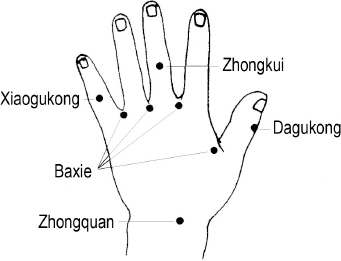
Location: At the midpoint of the proximal interphalangeal joint of the middle finger on the dorsal aspect (Extra points on the back of the hands).
Actions: Harmonizes the stomach and redirects its rebellious Qi.
Indications: Nausea, vomiting, hiccups.
Method: Acupuncture is not advisable. Moxibustion is applied with three moxa cones.
EX-UE 5 Dagukong (大骨空)
Name: Big Bone Hollow. The thumb is called the “big finger” in Chinese. “Bone Hollow” implies a point.
Location: At the midpoint of the interphalangeal joint of the thumb on the dorsal aspect.
Actions: Brightens the eyes and harmonizes stomach-Qi (Extra points on the back of the hands).
Indications: Eye diseases, vomiting, diarrhea.
Method: Acupuncture is not advisable. Moxibustion is applied with three moxa cones.
EX-UE 6 Xiaogukong(小骨空)
Name: Little Bone Hollow. It is on the little finger.
Location: At the midpoint of the proximal interphalangeal joint of the little finger on the dorsal aspect (Extra points on the back of the hands).
Actions: Brightens the eyes and sharpens hearing.
Indications: Eye and ear diseases.
Method: Acupuncture is not advisable. Moxibustion is applied with three moxa cones.
EX-UE 7 Yaotongdian (腰痛点)
Name: Lumbar Pain Point. The major indication of the point is lumbar pain.
Location: On the dorsum of the hand, between the second and third metacarpal bones and between the fourth and fifth metacarpal bones, midway between the transverse wrist crease and the metacarpophalangeal joints — four points in all on both hands (EX-UE 7 Yaotongdian).
Action: Relieves lumbar pain.
Indications: Acute lumbar sprain.
Method: Puncture obliquely 0.5–1 cun toward the center of the metacarpus from both sides. Moxibustion is applicable.
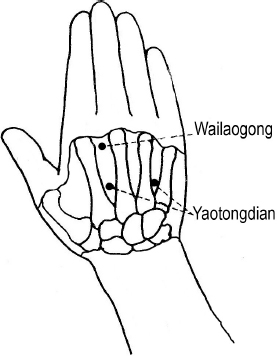
EX-UE 8 Wailaogong (外劳宫)
Name: Outer Labor’s Palace. The point is near PC 8 Laogong and thus shares its name.
Location: On the dorsum of the hand, between the second and third metacarpal bones, opposite PC 8 Laogong (EX-UE 7 Yaotongdian).
Action: Relieves pain.
Indications: Pain and stiffness of the neck, finger numbness.
Method: Puncture perpendicularly 0.2–0.5 cun. Moxibustion is applicable.
EX-UE 9 Baxie (八邪)
Name: Eight Evils/Pathogens. There are eight points in total under one name, functioning to dispel evils or pathogenic factors.
Location: On the dorsum of the hand, at the junction of light and dark skin of the finger webs, proximal to the web margins. There are eight points in all, best found while making a loose fist (Extra points on the back of the hands).
Action: Dispels pathogens.
Indications: Excessive heat, finger numbness, spasm and contracture of the fingers, redness and swelling of the dorsum of the hand, toothache, sore throat, redness and pain of the eyes.
Method: Puncture obliquely 0.3–0.5 cun or prick to cause bleeding. Moxibustion is applicable.
EX-UE 10 Sifeng (四缝)
Name: Four Seams. The transverse creases of the four figures where the point is located resemble seams.
Location: On the palmar surface, at the midpoint of the transverse creases of the proximal interphalangeal joints of the index, middle, ring, and little fingers (EX-UE 10 Sifeng).
Actions: Reinforces the spleen and helps digestion.
Indications: Malnutrition and indigestion syndromes in children, whooping cough.
Method: Prick to squeeze out a small amount of yellowish or whitish viscous fluid locally.
EX-UE 11 Shixuan (十宣)
Name: Ten Diffusions or Drainings. There are 10 points in total under this name, functioning to drain heat out of the body.
Location: On the tips of the 10 fingers, about 0.1 cun distal to the nails (EX-UE 10 Sifeng).
Actions: Clears heat and opens the orifices or resuscitates.
Indications: Coma, epilepsy, high fever, sore throat, infantile convulsions, numbness of the fingertips.
Method: Puncture perpendicularly 0.1–0.2 cun or prick to cause bleeding.
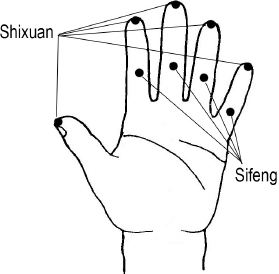
Jianqian (肩前)/Jianneiling (肩内陵)
Name: Shoulder Front/Inner Shoulder Mount. It is on the frontal part of the shoulder joint.
Location: Midway between the end of the anterior axillary fold and LI 15 Jianyu.
Actions: Benefits the shoulders and arms.
Indications: Frozen shoulder, shoulder Bi Syndrome, pain in the shoulder and arm, paralysis of the upper extremities.
Method: Puncture perpendicularly 0.8–1.2 cun (often with LI 15 and TE 14). Moxibustion is applicable.
Extra Points of the Lower Extremities (EX-LE)
EX-LE 1 Kuangu (髋骨)
Name: Hip Bone. It is located on the lower part of the femur.
Location: Two points on the lower part of the thigh, 1.5 cun left and right of ST 34 Liangqiu (Extra points on the legs).
Actions: Benefits the knee joint.
Indications: Knee pain, paralysis of the lower limbs.
Method: Puncture perpendicularly 0.5–1 cun. Moxibustion is applicable.
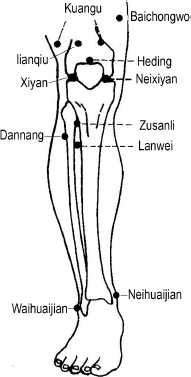
EX-LE 2 Heding (鹤顶)
Name: Crane’s Top. The patellar bone resembles the head of a crane, and the point is located directly above it.
Location: In the depression at the midpoint of the superior patellar border (Extra points on the legs).
Actions: Benefits the knee joint.
Indications: Knee pain, paralysis of the lower limbs.
Method: Puncture perpendicularly 0.3–0.5 cun. Moxibustion is applicable.
EX-LE 3 Baichongwo (百虫窝)
Name: Hundred Insects’ Nest. The point Functions to treat disorders caused by bacteria, insects, and parasites.
Location: One cun above SP 10 Xuehai (Extra points on the legs).
Actions: Clears blood heat, dispels wind, and resolves dampness.
Indications: Rubella, eczema, urticaria, boils on the lower portion of the body, gastrointestinal parasitic diseases.
Method: Puncture perpendicularly 1–2 cun. Moxibustion is applicable.
EX-LE 4 Neixiyan (内膝眼)
Name: Inner Knee Eye. The name refers to the location of the point on the inner aspect of the knee.
Location: In the depression medial to the patellar ligament, locating the point with the knee flexed (Extra points on the legs).
Actions: Benefits the knee joint and lower limb.
Indications: Knee pain, paralysis of the lower limbs.
Method: Puncture perpendicularly 0.5–1 cun. Moxibustion is applicable.
EX-LE 5 Xiyan(膝眼)
Name: Knee Eyes. The point is located in the two depressions on either side of the patellar ligament, like “eyes” of the knee.
Location: A pair of points in the two depressions, medial and lateral to the patellar ligament, located with the knee flexed. Knee Eyes includes Inner Knee Eye or EX-LE 4 Neixiyan and Outer Knee Eye or ST 35 dubi (Extra points on the legs).
Actions: Benefits the knee joint and lower limb.
Indications: Knee pain, paralysis of the lower limbs.
Method: Puncture perpendicularly 0.5–1 cun. Moxibustion is applicable.
EX-LE 6 Dannang (胆囊)/Dannangxue(胆囊穴)
Name: Gall Bladder/Gall Bladder Point. It treats gall bladder disorders.
Location: The tender spot 1–2 cun below GB 34 Yanglingquan (Extra points on the legs).
Actions: Transforms damp-heat and regulates the gall bladder.
Indications: Acute and chronic cholecystitis, cholelithiasis, biliary ascariasis, Wei (atrophy) Syndromes of the lower limbs.
Method: Puncture perpendicularly 0.8–1.2 cun. Moxibustion is applicable.
EX-LE 7 Lanwei (阑尾)/Lanweixue (阑尾穴)
Name: Appendix/Appendix Point. It treats appendix disorders.
Location: The tender spot is about 2 cun below ST 36 Zusanli (Extra points on the legs).
Actions: Redirects intestinal Qi downward and transforms damp-heat.
Indications: Acute and chronic appendicitis, indigestion, paralysis of the lower limbs.
Method: Puncture perpendicularly 1–1.2 cun. Moxibustion is applicable.
EX-LE 8 Neihuaijian (内踝尖)
Name: Tip of the Medial Malleolus. The name refers to its location.
Location: At the tip of the medial malleolus.
Actions: Clears heat and relieves pain.
Indications: Toothache, sore throat, spasm of the medial aspect of the calf muscle.
Method: Puncture perpendicularly 0.1–0.2 cun or use moxibustion.
EX-LE 9 Waihuaijian (外踝尖)
Name: Tip of the Lateral Malleolus. The name refers to its location.
Location: At the tip of the lateral malleolus.
Actions: Clears heat and relieves pain.
Indications: Toothache, sore throat, spasm of the lateral aspect of the calf muscle, Foot Qi (beriberi), urinary incontinence, headache.
Method: Puncture perpendicularly 0.1–0.2 cun, or prick to cause bleeding or use moxibustion.
EX-LE 10 Bafeng (八风)
Name: Eight Winds. There are eight points in total under this name, functioning to dispel pathogenic wind.
Location: On the dorsum of the foot, in the depressions of the webs between the toes, proximal to the web margins; there are eight points in all (Extra points on the front of the feet).
Actions: Dispels wind and clears heat.
Indications: Foot Qi or beriberi, toe pain, redness and swelling of the dorsum of the foot.
Method: Puncture obliquely 0.5–0.8 cun. Moxibustion is applicable.
EX-LE 11 Duyin (独阴)
Name: Solitary Yin. This is the only point under the toe on the plantar surface that belongs to Yin.
Location: On the plantar aspect of the second toe, in the center of the distal interphalangeal joint.
Actions: Harmonizes the stomach and regulates menstruation.
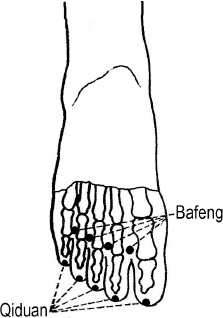
Indications: Abdominal pain, Shan Qi (hernia), vomiting, acid regurgitation, difficult labor, irregular menstruation.
Method: Puncture perpendicularly 0.1–0.2 cun. Moxibustion is applicable.
EX-LE 12 Qiduan (气端)
Name: Qi’s Extremities. The end of the toe is the place where Qi enters and exits.
Location: At the tip of each toe; a group of 10 points in total (Extra points on the front of the feet).
Actions: Soothes the tendons, relieves spasm, and resuscitates.
Indications: Foot Qi or beriberi, spasm of the feet, numbness of the toes, pain and swelling of the foot, unconsciousness.
Method: Puncture perpendicularly 0.1–0.2 cun or prick to cause bleeding. Moxibustion is applicable.

